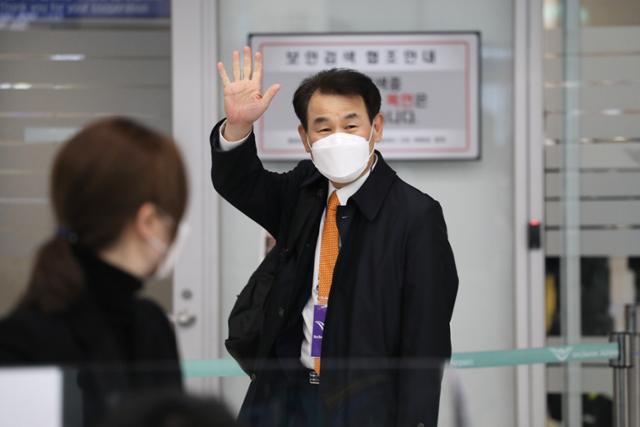
South Korea-US defense cost-sharing negotiation ambassador Jeong Eun-bo is waving his hand as he leaves the arrival hall at Incheon International Airport on the 9th. yunhap news
The ROK-US and the United States resolved the obstacles to the alliance with the conclusion of the 11th Defense Cost Sharing Agreement (SMA) negotiations, but it is criticized that linking the annual increase rate of South Korean contributions to the increase rate of defense spending is excessive concessions. This is because, as in the previous agreement, a large increase is inevitable every year compared to when linked to inflation rate. Many point out that the government’s explanation of “reasonable standards reflecting national power” is not convincing as the basis for adopting a different standard than before.
The Ministry of Foreign Affairs announced the results of the SMA negotiations on the 10th, saying, “The total amount for each year from 2022 to 2025 will be agreed by applying the increase rate of our defense expenditures in the previous year.” He explained that “the rate of increase in defense spending reflects the level of our finances and defense capabilities, is confirmed through the National Assembly deliberation, and is a reliable and reasonable standard that anyone can confirm clearly.”
The only case in which the contribution was increased based on the rate of increase in defense expenditure was the 10th Agreement in 2019, which is a one-year agreement. This is the first time in a multi-year contract agreement like this one. In the 9th Agreement, the inflation rate was reflected, but the rate of increase was not allowed to exceed 4%, but this time, the annual increase rate cap was not also stipulated. This is the reason why it is pointed out that it has been unreasonably pulled as a basis for meeting the demands of the US increase to some extent.
The linkage of the increase rate of defense expenditure and the absence of an upper limit of the rate of increase are pointed out as factors that steadily increase the rate of increase every year. In fact, if the budget increase rate in the defense medium-term plan announced last year is applied to the defense cost share, the Korean side’s burden in 2025, the last year of the agreement, will increase to about 1.5 trillion won. This is more than the $1.3 billion (approximately 1,480.8 billion won) that the Trump US administration asked for in the first year’s contributions last year. Shin Beom-cheol, director of the Center for Foreign Affairs and Security at the Institute for Economics and Social Affairs, pointed out, “If the first year was raised to 13.9%, the annual increase rate should have been prevented.”

The US military helicopters are moored at Camp Humphreys in Pyeongtaek, Gyeonggi-do, on the afternoon of the 8th, when the CCPT began in the first half of this year. Pyeongtaek = News 1
It seems that the inflation rate has been avoided because the domestic consumer inflation rate remains around 1%. According to the National Statistical Office, the growth rate of consumer inflation over the last three years was 1.5% in 2018, 0.4% in 2019, and 0.5% in 2020. If this is linked to the defense cost share, the share on the Korean side will hardly increase. A high-ranking official of the Ministry of Foreign Affairs explained, “We wanted to share what could be shared for a responsible and mutually beneficial alliance.” It seems that they also have in mind the’free alliance theory’ in the United States, which has been raised since the days of the Trump administration.
However, it is not enough to explain the reason for taking the rate of increase in defense spending as a standard. This is because the defense cost share, consisting of labor, construction, and logistical support costs, has a different character than the defense cost. Former Ambassador Hwang Joon-guk, who was the chief representative at the time of the 9th SMA signing in 2014, said, “The defense cost share and defense expenses seem similar at first glance, but this is an illusion.” did.
There is also an opinion that it is logical to have a structure in which the defense cost share decreases as the defense expenditure increases. Professor Kim Dong-yeop of North Korea Graduate School said, “The reason for increasing the defense expenditure is to increase the defense power, lower the dependence on the USFK, and to redeem the wartime combat control right.” .
Kang Yoobin reporter [email protected]
News directly edited by the Hankook Ilbo can also be viewed on Naver.

